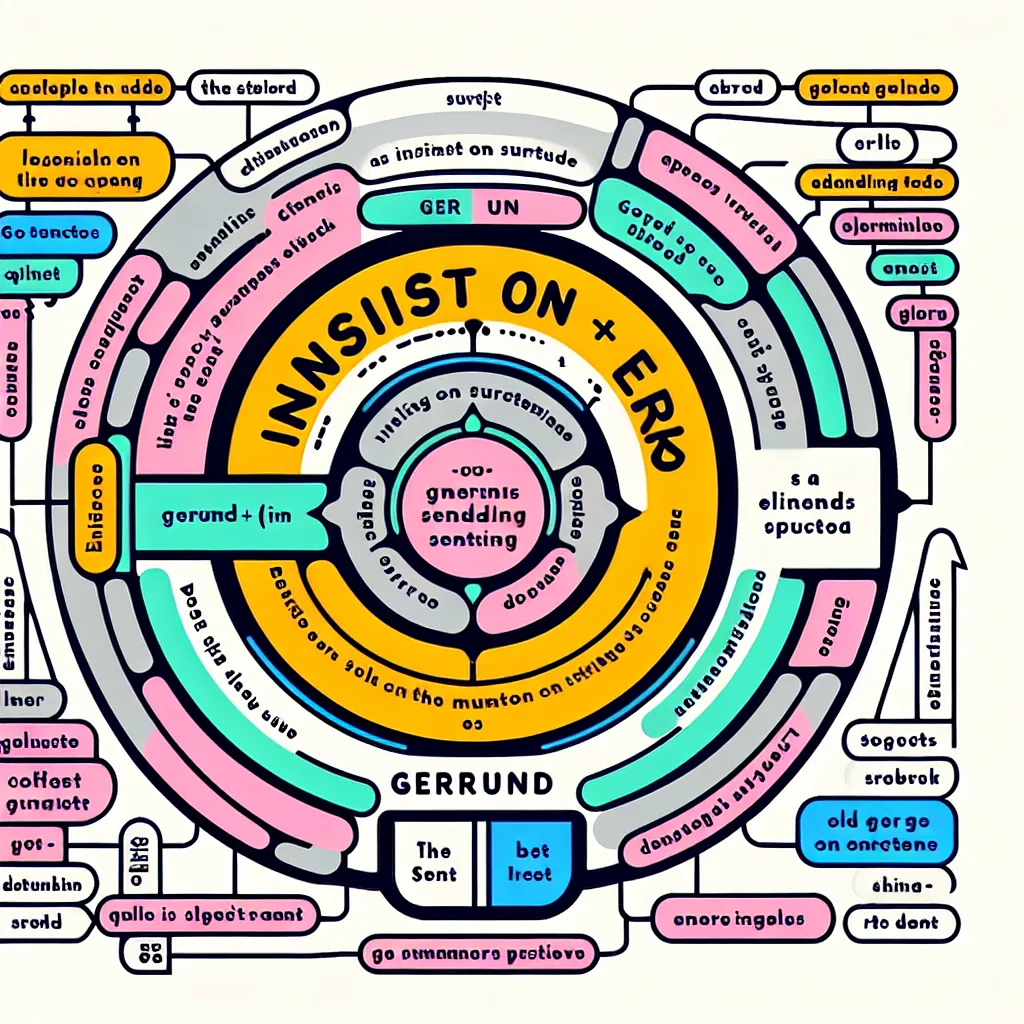The “insist on + gerund” structure is a crucial grammatical pattern that frequently appears in IELTS exams. Understanding and effectively using this construction can significantly enhance your language proficiency and boost your IELTS scores. Let’s delve into the intricacies of this structure and explore how to apply it across various sections of the IELTS test.
Understanding the “Insist on + Gerund” Structure
The “insist on + gerund” structure is used to express a strong demand or requirement for a particular action. It emphasizes the speaker’s firm stance on a specific course of action. This construction is commonly used in both formal and informal contexts, making it valuable for IELTS candidates across different task types.
Formula and Grammatical Analysis
The basic formula for this structure is:
Subject + insist + on + verb-ing
Let’s break down the components:
- Subject: The person or entity making the demand
- Insist: The main verb indicating a strong requirement
- On: The preposition that always follows “insist” in this context
- Verb-ing: The gerund form of the verb, representing the action being insisted upon

Application in IELTS Writing
In IELTS Writing, using the “insist on + gerund” structure can demonstrate your grammatical range and accuracy. Here are some examples of how you can incorporate this structure in your essays:
-
Task 2 Essay:
“Many environmentalists insist on implementing stricter regulations to combat climate change.” -
Task 1 Report:
“The data clearly shows that the company insisted on maintaining high quality standards throughout the production process.” -
Task 2 Argument:
“While some parents insist on controlling every aspect of their children’s lives, others advocate for more independence.”
By using this structure, you showcase your ability to express strong opinions and describe firm actions, which can contribute to a higher band score in the Grammatical Range and Accuracy criterion.
Enhancing IELTS Speaking Performance
The “insist on + gerund” structure can also be effectively utilized in the IELTS Speaking test to express opinions and describe situations with precision. Consider these examples:
-
Part 2 (Cue Card):
“I remember my father insisted on teaching me how to drive when I was 18. He believed it was an essential life skill.” -
Part 3 (Discussion):
“In my country, the government insists on implementing strict road safety measures to reduce accidents.” -
Part 1 (Interview):
“My university insists on students participating in community service activities as part of our curriculum.”
Using this structure in your speaking responses demonstrates your ability to use complex grammar naturally, potentially leading to higher scores in the Grammatical Range and Accuracy and Fluency and Coherence criteria.
Improving IELTS Reading and Listening Skills
Recognizing the “insist on + gerund” structure in IELTS Reading and Listening passages can aid in comprehension and answering questions accurately. Here are some examples you might encounter:
-
Reading Passage:
“Environmental activists insist on preserving natural habitats to protect endangered species.” -
Listening Dialogue:
“The project manager insisted on meeting the deadline, despite the team’s concerns about quality.”
Being familiar with this structure allows you to quickly identify key information and main ideas in texts and audio materials.
Common Mistakes and How to Avoid Them
To achieve higher band scores, it’s crucial to avoid common errors when using the “insist on + gerund” structure. Here are some mistakes to watch out for:
-
Incorrect verb form:
- Incorrect: “He insists on to go to the party.”
- Correct: “He insists on going to the party.”
-
Omitting ‘on’:
- Incorrect: “They insist having a written agreement.”
- Correct: “They insist on having a written agreement.”
-
Using the wrong preposition:
- Incorrect: “The teacher insists for completing the assignment on time.”
- Correct: “The teacher insists on completing the assignment on time.”
-
Confusion with infinitive structures:
- Incorrect: “She insists on to speak to the manager.”
- Correct: “She insists on speaking to the manager.”
-
Passive voice mistakes:
- Incorrect: “It is insisted on being done immediately.”
- Correct: “They insist on it being done immediately.”
By avoiding these errors, you demonstrate a higher level of grammatical accuracy, which is crucial for achieving band 7 and above in IELTS.
Strategies for Band 7+ Usage
To elevate your use of the “insist on + gerund” structure to band 7 and above, consider these advanced strategies:
-
Combine with complex sentences:
“Despite the potential economic drawbacks, environmentalists insist on implementing stricter regulations, arguing that the long-term benefits outweigh short-term costs.” -
Use with idiomatic expressions:
“The company’s board of directors insisted on leaving no stone unturned when investigating the financial discrepancies.” -
Incorporate into conditional statements:
“If the government had insisted on enforcing stricter building codes, the damage from the earthquake might have been less severe.” -
Employ in reported speech:
“The union representatives reported that management had insisted on cutting benefits, which led to the strike.” -
Utilize in passive constructions:
“It was widely known that quality control was insisted on being maintained at the highest level throughout the production process.”
These advanced applications demonstrate a sophisticated command of English grammar, potentially leading to higher band scores across all sections of the IELTS test.
Conclusion
Mastering the “insist on + gerund” structure is a valuable asset for IELTS success. By understanding its usage, avoiding common mistakes, and applying it effectively across different test sections, you can enhance your overall language proficiency and improve your chances of achieving your desired IELTS score. Remember to practice using this structure in various contexts and continue to expand your grammatical range for optimal performance in the exam.